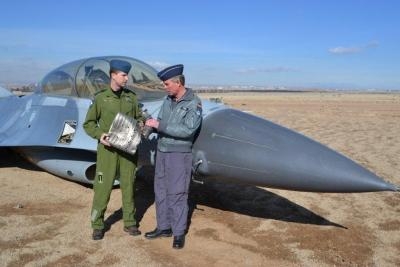German, Canadian Officers Participate In Accident Investigation Training
Two international officers assigned to the Air Force Safety Center's Aviation Safety Division have bolstered their countries' aviation safety program by working side-by-side with their U.S. Air Force partners. German Air Force Lt. Col. Rudi Stein and Royal Canadian Air Force Maj. Peter Laurin agree that aircraft investigation concepts and principles among their services and those of the U.S. Air Force are consistent: collect data, analyze it and make recommendations to prevent further mishaps. But, it's the chance to work alongside U.S. pilots with extensive aviation safety experience and knowledge of safety practices in similar airframes that will enable them to enhance their own countries' aviation safety programs.

Stein, who recently completed a four-year assignment in the exchange program and has just returned to the Flight Safety Office in Cologne, Germany, was assigned to the operations branch where he was responsible for mishap report quality control. The branch manages the mishap investigation report staff review and final evaluation processes. All Class A and B mishap reports must be scrubbed to meet the Air Force chief of safety's standards for completeness and investigative rigor. After reports are released in the safety center's electronic database, the Air Force Safety Automated System, they are open for comments for a 45-day period. Then, the branch prepares the Air Force's official position on findings, causes and recommendations.
Within his four-year assignment, Stein reviewed more than 250 reports and attended more than 100 recommendation closure sessions. "It's very intense work," he said during an interview before returning to Germany. "The reports must be thorough and correct because the recommendations have a direct impact on aviation safety."
A former Army aviator with 2,000 flying hours in the UH-1, and Transall C-160 pilot, Stein supported three investigations during his tour at the safety center. The U.S. Air Force process of collecting and analyzing data and creating recommendations closely mirrors the GAF process, he said, with one remarkable difference: time. With fewer than 400 aircraft that average less than a total of 100,000 flying hours a year, the German Armed Forces have only one or two Class A mishaps a year.
According to Stein, a German investigation team might spend a few days at the crash site and return to their unit where they continue their investigation while managing other primary and emergent duties, meaning that some investigations could take up to six months. The longest investigation he's aware of lasted two years. "But the U.S. Air Force gathers an expert team, spends up to several weeks at the mishap unit, and the team members are dedicated to that investigation until it's concluded," Stein said. "In most cases, the investigation is finalized within 30 days."
After graduating college and flying as a bush pilot in northern Canada, Laurin then went on to complete RCAF pilot training. Twenty years later, having flown trainers and fighters, Laurin has logged more than 5,000 flying hours. Laurin had little safety investigation experience in Canada but believes his diverse flying experience equipped him well to work in aviation safety. To prepare for the safety center assignment, he completed the Canadian Flight Safety course and spent the first month at the safety center completing the Safety Investigation Board President course and the Aircraft Mishap Investigation course.
Though the RCAF is responsible for all aircraft operations of the Canadian forces, the size of the entire aircraft inventory, about 390, means the RCAF has proportionately fewer aircraft mishaps than the U.S. Air Force. At only a year and a half into a three-year assignment, Laurin has already supported two on-site accident investigations. One involved an A-10 crash in Germany and the other an F-16 crash with fatality at Nellis AFB, Nev. He has also provided telephonic assistance for numerous mishap investigations on diverse U.S. Air Force airframes including the C-130, F-16, C-17, F-35 and CV-22. "It amazed me how well the entire investigation team worked together during an intense 30 days," Laurin said. "And each day, we discovered new information helping us add another piece and eventually solve the mishap investigation puzzle."
As a staff officer in the investigations branch, Laurin helps support all Class A and B aviation mishaps. The branch provides assistance and oversight of the aircraft mishap investigation process until the safety investigation board delivers its report to the convening authority. Once the convening authority accepts the safety investigation board's report, it's handed over to the operations branch for the final evaluation process. "The real benefit of the exchange program is that we glean safety information about the airframes common to U.S., German and Canadian militaries that we can take back and use to decrease mishaps," Laurin said. "We work with people who have flying backgrounds in similar aircraft with years of experience, who spot safety deficiencies that others without that same expertise can't."
"The exchange program helps us maintain the strong relationships we already have with the militaries of our international partners," said Randy Rushworth, deputy chief of aviation safety. "The experiences, professional knowledge and doctrines of the U.S. Air Force, GAF and RCAF are shared for mutual benefit because mishap prevention is No. 1 for all of us in the aviation community." (Pictured: L-R Royal Canadian Maj. Peter Laurin, German Air Force Lt. Col. Rudi Stein. USAF Photo)
 ANN's Daily Aero-Linx (04.13.24)
ANN's Daily Aero-Linx (04.13.24) ANN's Daily Aero-Term (04.13.24): Beyond Visual Line Of Sight (BVLOS)
ANN's Daily Aero-Term (04.13.24): Beyond Visual Line Of Sight (BVLOS) Airborne 04.09.24: SnF24!, Piper-DeltaHawk!, Fisher Update, Junkers
Airborne 04.09.24: SnF24!, Piper-DeltaHawk!, Fisher Update, Junkers Aero-News: Quote of the Day (04.14.24)
Aero-News: Quote of the Day (04.14.24) ANN's Daily Aero-Term (04.14.24): Maximum Authorized Altitude
ANN's Daily Aero-Term (04.14.24): Maximum Authorized Altitude



